Windows Vista opis polski - ![]()
Microsoft Windows Vista (wersja robocza to Windows NT 6.0) to nowa edycja systemu Windows firmy Microsoft (do 22 lipca 2005 znany był jedynie pod nazwą kodową Longhorn). Będzie następcą systemu Windows XP. Hasło systemu to Clear Confident Connected, czyli Czysty, pewny, połączony. Jego premiera planowana jest na drugą połowę 2006.
Spis treści
[schowaj]
* 1 Nowości w Windows Vista
* 2 Wersje
* 3 Technologie
* 4 Interfejs
* 5 Wymagania sprzętowe
* 6 Graficzne wymagania sprzętowe
o 6.1 Aero Glass
o 6.2 Aero Diamond
o 6.3 Aero Express
o 6.4 To Go
o 6.5 Classic
* 7 Historia wydań
* 8 Linki zewnętrzne
Nowości w Windows Vista
Trójstopniowo (zamiast dwustopniowo) limitowane konta, dzięki którym będzie można lepiej dopasować
poziom uprawnień do użytkownika. Nowy rodzaj kont, Least Privileged User Account (LUA), któremu
zawdzięczamy trójstopniowe uprawnienia, jest najbardziej ograniczony i sprowadza się do jedynie
podstawowych uprawnień, takich jak korzystanie z internetu (jest możliwe odcięcie takiemu
użytkownikowi dostępu do niektórych stron) czy eksploracja jego własnych folderów.
Windows Vista będzie kładł olbrzymi nacisk na bezpieczeństwo systemu. Zostanie wprowadzony nowy model
aktualizacji tzw. hot patching, gdzie poprawki będą wprowadzane bez restartowania systemu.
Pozostałe nowości:
* Dzięki nowej technologii ładowania i zamykania systemu, system będzie wracał ze stanu
wstrzymania w nie więcej niż 2 sekundy, a ładowanie się systemu będzie trwało o połowę krócej niż
w Windowsie XP.
* Aplikacje będą ładować pliki 15% szybciej niż w Windowsie XP.
* Nowy instalator, który potrafi zainstalować system w 15 minut.
* Nowe narzędzia ułatwiające wdrażanie systemu (m.in. narzędzie do tworzenia obrazów dysków
twardych).
* Zostanie zmodyfikowana funkcja Przywracania systemu, w której będzie istnieć mniej koniecznych
punktów przywracania, co jest równoznaczne z oszczędnością miejsca na dysku.
* Nowa, szybka wyszukiwarka plików; będzie potrafiła na wszelakie sposoby przeszukiwać pliki,
dokumenty, zdjęcia, i inne multimedia, a także grupować zbiory według autora, daty modyfikacji,
rozmiaru itd.
* Zostanie ułatwione przenoszenie danych między komputerem a urządzeniami przenośnymi.
* Nowa wersja przeglądarki Internet Explorer oznaczona numerem 7. Będzie oferować niektóre z
funkcjonalności nowoczesnych i bezpiecznych przeglądarek (np. Mozillę Firefox i Operę),
usprawniające surfowanie i bezpieczeństwo. Pierwsza wersja testowa przeglądarki ukazała się razem
z wersją Beta 1 systemu Windows Vista, czyli 27 lipca 2005
* Nowy mechanizm logowania błędów, znany pod nazwą kodową Crimson. Jego zadaniem będzie
monitorowanie, zarządzanie i raportowanie "stanu zdrowia" systemu.
* Nowy format dokumentów bazujacy na XML-u (alternatywa dla PDF). Jego nazwa kodowa to Metro.
* Nowa wersja odtwarzacza multimediów Windows Media Player, prawdopodobnie oznaczona numerem 11.
* Windows Driver Foundation - o wiele lepsza obsługa sterowników sprzętu podłączonego do
komputera.
* Obsługa formatu HD DVD oraz prawdopodobnie Blu-ray. Płyty tych technologii być może będą sięgać
nawet do 1 TB (terabajta).
* Windows Vista ma obsługiwać dodatkowy, mały ekran LCD (o przekątnej ok. 3") montowany w
niektórych komputerach przenośnych. Ma być na nim pokazywany m.in. stan baterii, zegar oraz
informacje o nowych wiadomościach e-mail.
* Możliwe, że w systemie pojawi się nowa wersja programu Microsoft Paint, niezmienionego (poza
drobnymi poprawkami) od 1995 roku. Aktualnie jest ona znana pod nazwą Paint.NET [1], tworzy ją
grupa studentów z Washington State University pod czujnym okiem Microsoftu.
* Obsługa tworzonej przez Microsoft sieci P2P znanej obecnie pod nazwą kodową Avalanche.
* Co najmniej 6 nowych czcionek: 2 szeryfowe (Cambria i Constantia), 3 bezszeryfowe (Calibri,
Candara i Corbel) oraz jedna o stałej szerokości znaku (Consolas).
* Nowy sposób obługi tekstu i czcionek z wykorzystaniem Unicode i możliwości "Avalona" w zakresie
skalowania.
* Obsługa dowiązań symbolicznych systemu Unix.
Wersje
Przewidywane są następujące wersje systemu:
* Windows Vista Home Edition
* Windows Vista Premium/Media Center Edition
* Windows Vista Professional Edition
* Windows Vista Small Business Edition
* Windows Vista Mobility/Tablet PC Edition
* Windows Vista "Uber" Edition - będzie łączyć funkcjonalność wszystkich wersji
* Windows Vista Starter Edition - najmniej funkcjonalna wersja, przeznaczona na rynki krajów
rozwijających się
Wszystkie wersje (za wyjątkiem Starter Edition) będą dostępne w wersjach 32- i 64-bitowej, co razem
daje 13 wersji systemu.
Są to jedynie przypuszczenia, Microsoft nie zdecydował ostatecznie jeszcze ile i jakie edycje będą
dostępne. Wiadomo jednak, że Microsoft chce wydać jak najwięcej edycji, aby jak najlepiej dopasować
produkt do wymagań klientów.
Technologie
Windows Vista będzie wyposażony w szereg nowych technologii. Najważniejsze z nich to:
* Windows Presentation Foundation (Avalon)
* Windows Communication Foundation (Indigo)
* WinFX
Inaczej niż początkowo zakładano, do systemu nie będzie dołączony system plików WinFS, ponieważ firma
przewiduje, że nie zdąży go dopracować przed terminem wydania systemu.
Interfejs
Windows Vista będzie zawierał 3 rodzaje interfejsu: Aero Glass, Aero i interfejs klasyczny. Aero
będzie uproszczoną wersją Aero Glass, zaprojektowaną dla komputerów, które nie spełniają wymagań
sprzętowych Aero Glass. Na najsłabszych komputerach zostanie użyty klasyczny interfejs, znany z
aktualnych wersji systemu Windows. Możliwe również, że w wersji Media Center Edition oraz w wersji
"Uber" pojawi się także Aero Diamond.
Aero i Aero Glass będą zawierały nowe, trójwymiarowe efekty. Aero Glass dodatkowo będzie sprawiał
wrażenie gładkości i przezroczystości interfejsu.
Na starszych komputerach, posiadających słabsze karty graficzne i procesory, tych efektów nie będzie i
system będzie wyglądał porównywalnie do poprzednich wersji. Aby w pełni wykorzystać efekty 3D nowego
systemu, karta graficzna będzie musiała posiadać technologię Longhorn Display Model Driver (LDDM)
Nowością będzie także tzw. sidebar. Będzie można do niego "podpiąć" różne aplikacje, takie jak
odtwarzacz multimedialny, zegar, czytnik RSS czy kalendarz (oczywiście, będzie można go wyłączyć).
Wymagania sprzętowe
Poniżej podano oficjalne minimalne wymagania wstępnego wydania systemu Windows o nazwie kodowej
Longhorn (jeszcze przed nadaniem nazwy Windows Vista) rozdanego na konferencji WinHEC w kwietniu 2005.
* Procesor 233 MHz
* 256 MB pamięci RAM
* 6 GB wolnego miejsca na dysku podczas instalacji systemu
* Napęd DVD
Nie są to wymagania finalnej wersji, które mogą się różnić od podanych tutaj.
Testerzy twierdzą, że do stabilnej pracy systemu potrzebny jest procesor 1 GHz oraz 384 MB pamięci
RAM. Po instalacji system zajmuje na dysku twardym 5 GB.
Graficzne wymagania sprzętowe
Wymagania graficzne systemu Microsoft Windows Vista są zależne od ustawień interfejsu.
Aero Glass
Ten tryb graficzny dodaje obsługę grafiki 3D, animacji i specjalnych efektów wizualnych w porównaniu
do możliwości trybu Aero Express. Tryb ten jest dostosowany do wydajnych kart graficznych. Wymagania:
* Co najmniej 64 MB pamięci karty graficznej, zalecane 128 MB, albo 256 dla rozdzielczości
1600x1200+.
* Co najmniej 32 bity na piksel.
* Sprzętowa akceleracja graficzna obsługująca DirectX 9.
* Przepustowość pamięci 2 GiB / sekundę.
* Możliwość rysowania ok. 1.5M trójkątów/sekundę, jedno okno ok. 150 trójkątów.
* Karta graficzna używająca AGP 4X albo PCI Express.
Jest wysoce prawdopodobne, iż tryb ten będzie domyślnym przy starcie systemu Vista.
Aero Diamond
Tryb graficzny dostosowany do Vista Media Center Edition. Nie będzie dostępny w innych edycjach
systemu. Jak do tej pory nie ma dokładnych informacji na temat tego trybu, ale wygląda na to, iż
będzie on najbardziej zaawansowanym graficznie trybem w Windows Vista, wymagającym nawet więcej niż
tryb Aero Glass.
Aero Express
Mniej wzbogacona wersja Aero Glass, wprowadzająca tylko podstawowe udoskonalenia wprowadzene w
systemie Vista. Używa Avalon Desktop Composition. Wymagania:
* Vista Driver Display Model (LDDM)
Niektóre karty graficzne obsługują już LDDM. W niektórych wersjach rozwojowych Visty (4074,5048) LDDM
umożliwia uruchamianie Aero Glass.
To Go
Styl graficzny z małą ilościa efektów wizualnych, podobny do stylu Luna systemu MS Windows XP. Tak jak
w przypadku Luny nie ma żadnych dodatkowych wymagań sprzętowych w porównaniu do klasycznego interfejsu
systemu Microsoft Windows.
Na kilka dni przed planowaną premierą, Microsoft udostępnił pierwszą testową wersję Windows Vista.
Beta dostępna jest za pośrednictwem Windows Vista Technical Beta Program, MSDN Developer Program oraz
Microsoft TechNet.
Testowa wersja została przygotowana z myślą o programistach, specjalistach IT i osobach
zainteresowanych zapoznaniem się z nowościami w zakresie bezpieczeństwa, stabilności oraz zarządzania
systemem. Użytkownicy zobaczą również wstępną wersję szaty graficznej Windows Vista i będą mieli
możliwość przetestować dołączoną do systemu wersję beta przeglądarki Internet Explorer 7.
Testową wersję Windows Vista wyposażono w zaawansowane technologie ochrony kont użytkownika i danych,
a także firewall oraz funkcję identyfikacji i usuwania z dysku szkodliwego oprogramowania. Użytkownicy
będą mieli również możliwość zapoznania się z rozszerzoną funkcjonalnością w zakresie pracy grupowej i
wymiany plików oraz wyszukiwania i organizowania zawartych na dysku informacji.
Programiści i specjaliści IT oraz wszyscy zainteresowani mogą pobrać testową wersję Windows Vista za
pośrednictwem Windows Vista Technical Beta Program, MSDN Developer Program oraz Microsoft TechNet.
Nasz download jest specyficzny ponieważ obecnie nic na nim się nie znajduje.
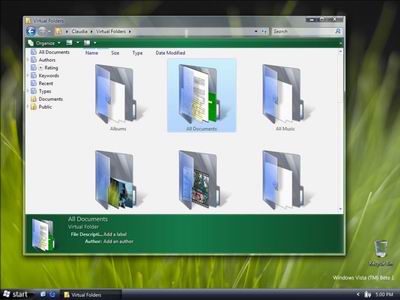
Windows Vista download screen

Windows Vista download screen
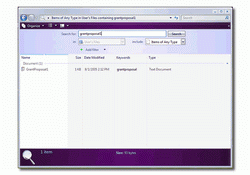
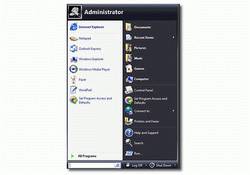
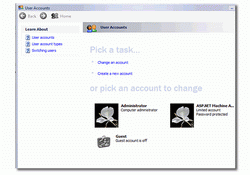

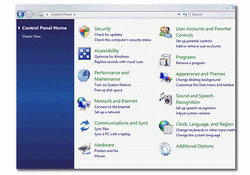
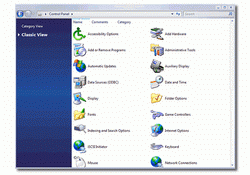
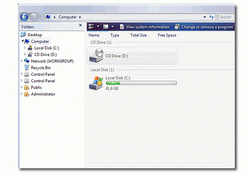
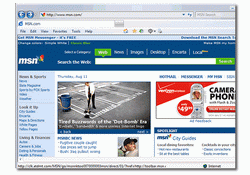
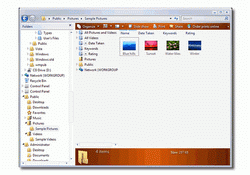
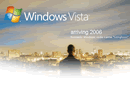
Windows Vista english - ![]()
Windows Vista, abbreviated WinVI, is Microsoft's next version of its
Windows operating system, succeeding to Windows XP. It was previously
known by its codename Longhorn (see the other Microsoft codenames). The
name "Vista" was unveiled on July 22, 2005. Longhorn Server, the successor
of Windows Server 2003, is yet to be named. Windows Vista will carry the
version number 6.0 (Windows 2000, Windows XP and Windows Server 2003 being
Windows NT versions 5.0, 5.1 and 5.2, respectively). The scheduled release
date for Windows Vista is December 7, 2006.
Windows Vista has several planned new features such as an entirely new
user-interface called Aero, improved searching technology dubbed Search,
and an XML specification designed for document formats and similar in many
ways to Adobe's PDF entitled XPS. Windows Vista also has an entirely new
development API, WinFX, along with several other key technologies. In
addition, current speculation points to several different editions of
Windows Vista being released, including starter, home, and professional
editions. The new operating system had several previously scheduled
features that are currently not planned to go into the operating system
such as WinFS and the new command shell MSH. System requirements of the
new software are also higher than previous versions of Windows.
Contents
* 1 Important Builds
* 2 Overview
* 3 Editions
* 4 Technologies
* 5 Features
o 5.1 Aero
o 5.2 Search
o 5.3 XML Paper Specification (XPS)
o 5.4 Shell
o 5.5 Networking
o 5.6 Other features and changes
* 6 Features and technologies delayed until future releases
* 7 Graphics hardware requirements
o 7.1 Aero Diamond
o 7.2 Aero Glass
o 7.3 Aero Express
o 7.4 To Go (Luna, Windows XP)
o 7.5 Classic (Windows 2000)
* 8 Hardware requirements
* 9 Official Screenshots
* 10 See Also
* 11 References
* 12 External links
Important Builds
* Build 3663-First Known Build, incorporated Plex theme.
* Build 4008-Introduced several new features
* Build 4051-Introduced new Slate theme
* Build 4074-Introduced new Jade interface
* Build 5048-Introduced new Aero Glass interface; Windows Server 2003 SP1 Codebase
* Build 5112-Initial Beta Build
* Build 5219-First "Ultimate Edition" build, includes Smart Fetch
* Build 5231-Newest leaked build and October CTP
Overview
Windows Vista was originally expected to ship sometime early in 2006 as a
minor step between Windows XP and Windows Blackcomb. Gradually, Vista
assimilated many important new features and technologies of Blackcomb. In
August 2004, Microsoft announced that it was making changes to what was
then only known as "Longhorn". Microsoft basically started development
afresh, building on the Windows Server 2003 codebase. This decision was
reached in the wake of Windows XP Service Pack 2. As part of this
decision, Microsoft announced that it is delaying the release of WinFS so
that Vista could be released in "a reasonable timeframe". Due to this,
WinFS will not be included in Windows Vista.
Two beta versions of Windows Vista are planned; the first was released on
July 27, 2005, and beta 2 somewhere between November 2005 to February 2006
with release candidates to be released throughout 2006. The currently
scheduled release of the full version of Windows Vista is December 7,
2006. The projected release date is five years after the release of
Windows XP, making this the longest time span between releases of desktop
versions of Microsoft's Windows operating system.
Vista Beta 1 (build 5112) is currently available to Microsoft Developer
Network (MSDN) subscribers as well as a select group of Microsoft Beta
testers and at select Microsoft developer conferences such as the
Professional Developers Conference (PDC) and WinHEC. The preview release
is classified as a beta version at the moment, although its feature set is
not representative of the release product. Like many other products
(including all Windows releases since Windows 98), it has since been
leaked onto popular networks (file sharing or otherwise) such as IRC,
BitTorrent and various newsgroups. However, most of these instances are
viruses going by the Vista name in order to draw in victims.
A beta refresh is being given to 2005 PDC attendees and has been released
to Microsoft Beta testers (and now also to MSDN subscribers) with the
build number 5219. This refresh contains the Windows Sidebar, which had
been removed from previous builds without explanation. Build 5219 is
expected to be the closest to Beta 2 the public will see before the actual
release of Beta 2 later this year. Its projected release is anywhere from
November to late February. Microsoft will however release less publicized
monthly interim releases to developers during this time.
Although Microsoft have stated that WinFS will not make its wide reaching
debut in Windows Vista, users of the current 5219 build have noticed that
in fact WinFS is included in that version. Several Windows 'rumour' sites
and newsgroups such as Neowin and Paul Thurrott's Windows SuperSite have
made speculation that WinFS will in fact be ready on time for Windows
Vista's release.
About a week after build 5219, build 5231 was released, which includes a
new version of Windows Media Player (version 11). The build has leaked
onto bit torrent networks, but many of the links are dead.
Editions
It is rumored that Windows Vista will ship in nine editions.
* Windows Vista Starter Edition: (Only available in emerging markets)
Much like the Windows XP Starter Edition, this edition will be limited
to emerging markets mainly to offer a legal alternative to piracy. It
will be severely limited, for example only allowing a user to launch
at most three applications at once. This is the only edition that will
not support 64-bit processors.
* Windows Vista Home Basic Edition: Similar to Windows XP Home Edition
for budget users not requiring advanced media support for home use.
* Windows Vista Home Basic Edition N: (Only available in Europe)
Identical to Windows Vista Home Basic Edition except Windows Media
Player is not included. This edition is mandated by European law, to
allow more competitiveness among media applications available for
Windows.
* Windows Vista Home Premium Edition: Based on the Windows Vista Home
Basic Edition, this edition will additionally support more advanced
features aimed for the home market segment, such as HDTV support and
DVD authoring. This edition will be comparable to a Windows XP Home
edition combined with features from the Windows XP Media Center
Edition and some additional features.
* Windows Vista Professional Edition: Comparable to Windows XP
Professional, and aimed at the business market. Adding support for
Windows Server domains, which all Home editions will lack. This
edition will also come with the Internet Information Services web
server in a new version.
* Windows Vista Professional Edition N: (Only available in Europe)
Identical to Windows Vista Professional Edition except Windows Media
Player is not included, for the same reason as with Home Basic Edition
N.
* Windows Vista Small Business Edition: This edition is aimed for
small businesses lacking an IT staff, and therefore comes with a
number of integrated system maintenance features, although not
necessarily enough to be comparable to a full fledged server. It will
support backup and shadow copies, and also come with fax and scanning
utilities, and a special version of Microsoft's upcoming antivirus
tool Windows OneCare. It may also come with a pre-paid Microsoft
Office Live! subscription.
* Windows Vista Enterprise Edition: (Only available through enterprise
agreements) Aimed for the enterprise segment, and functionally like a
superset of the Professional Edition, this edition will among other
things ship with Microsoft's Virtual PC system virtualization
software, and a multilingual user interface. This edition will not be
available through retail or OEM's.
* Windows Vista Ultimate Edition: This edition will work as a superset
of the Home and Professional editions and additionally come with
podcasting support, a game performance tweaker, and possibly
supporting special online services for e.g. downloadable media. The
Ultimate Edition is aimed to be the most impressive edition of Vista,
aimed for high-end PC users, gamers, and multimedia professionals.
Technologies
Microsoft labels the new key technologies in the new Windows version as
"The Pillars of Vista".
* Fundamentals: new developments to the basic structure of the
operating system including the .NET framework, a new audio framework,
further support for digital rights management (DRM), an application
deployment engine ("ClickOnce"), improvements to the installation of
applications (Windows Installer/MSI 4.0), and the controversial
Trustworthy Computing initiative previously known as Palladium (see
also trusted computing).
* Windows Presentation Foundation or WPF, formerly code named Avalon:
a new user interface subsystem and API based on XML, .NET, and vector
graphics, which will make use of 3D computer graphics hardware and
Direct3D technologies. See Windows Graphics Foundation.
* Windows Communication Foundation or WCF, formerly code named Indigo:
a service-oriented messaging system to allow programs to interoperate
locally or remotely similar to web services.
* WinFX (not to be confused with "WinFS"): a new API to allow access
to these new features.
WPF, WCF, and WinFX are technologies that Microsoft is hoping to make
available to Windows XP and Windows Server 2003 as well, and are therefore
not technologies exclusive to Vista, but rather developed in time for the
Vista release. However, Aero will still be exclusive to Vista. The reason
for backporting these technologies is to allow an easier introduction to
these technologies to developers and end users. On March 26th Microsoft
released a Community Preview for both WPF and WCF to enable developers to
experiment with the new technologies without running the Alpha version of
Vista. Later, due to a proliferation of requests the preview was made
available to the general public at Microsoft's website.
Features
Several new features have been planned for Vista. Neither the final
feature set nor the extent to which the different editions would contain
different features has been fully clarified as of September 2005. Some
features have been cut since Longhorn was initially announced in 2003.
Aero
AERO is an acronym (or backronym) for Authentic, Energetic, Reflective,
and Open.
Vista will include a re-designed user interface, code-named Aero. The new
interface is intended to be cleaner and more aesthetically pleasing than
previous Windows, including new transparencies, animations and eye candy
implemented similarly to Mac OS X's Quartz Compositor, which originally
shipped in 2001. As of yet, little or nothing has been shown of Aero in
public/leaked builds. However, Microsoft makes it clear that the changes
are by no means superficial. The previous UI was Plex, which was featured
in Longhorn versions 4008-4051.
Search
Vista will feature a new search engine that will allow for instant display
of results for a given search, in a manner similar to Google Desktop and
Microsoft's Windows Desktop Search. This is in contrast to the search
engine of Windows XP, which can take several minutes to display results.
The Vista search will allow users to add multiple filters to continually
refine search results (Such as "File contains the word 'example'"). There
will also be saved searches that will act as virtual folders (rather like
the smart folders of Mac OS X Tiger), where opening a folder will execute
a specific search automatically and display the results as a normal
folder. These virtual folders are also distributable via RSS. Unlike
Tiger's smart folders or Microsoft Outlook 2003, however, users will not
be able to open the files directly from the virtual folder in the same way
as through the Windows Explorer. The Vista search is built on an expanded
and improved version of the Indexing Service from previous versions of
Windows. Searching in Vista will also allow users to search across RSS and
Atom feeds, straight from Explorer.
Also like Apple's Spotlight, programs specifically developed for Vista can
also add search to their own programs. Vista will use also IFilters [1]
that are used today by Windows Desktop Search. The IFilter interface can
be implemented by software makers so that files created by their
applications can be better integrated with search and indexing programs.
The search functionality will be upgraded again when WinFS is released.
XML Paper Specification (XPS)
XPS was formerly known as "Metro", and is Microsoft's next generation
document format, which is based on XML. It is similar in many ways to
Adobe Systems' PDF. XPS is intended to allow users to view, print, and
archive files without the original program that created them. The name XPS
also refers to one of the print paths in Windows Vista. With XPS,
documents can remain in the same format from the time they are created to
the time they are printed. Microsoft states that XPS will provide better
fidelity to the original document by using a consistent format for both
screen and print output.
While some suspect XPS is intended to be a "PDF-killer", Microsoft insists
that they are not attempting to duplicate all the functionality of the
PDF. For example, at the time of this writing, XPS is not planned to have
the capabilities for dynamic documents.
XPS is a subset of Windows Presentation Foundation, allowing it to
incorporate rich vector-graphic elements in documents. The elements used
are taken to a lower level (i.e. described in terms of paths) to allow for
portability across platforms. In effect, it consists of XAML files, with
necessary fonts, zipped in a package.
Shell
The new shell is a significant change from previous versions of Windows.
Combined with the new desktop searching feature, the shell gives users the
ability to find and organize their files in new ways. Apart from the
typical file organization practice of using folders to contain files, a
new collection known as Lists lets users organize files from multiple
locations in a single place.
A new type of folder known as a Shadow Folder has the ability to revert
its entire contents to any arbitrary point in the past. Shadow Folders
utilize a transactional storage feature in the newest NTFS release.
Additionally, the shell contains significant advancements in the
visualization of files on a computer. Previous versions of the Windows
Shell would display thumbnails to represent different files on the
computer. In Windows Vista the thumbnail concept is taken further by
overlaying different imagery to communicate more information about the
particular file such as a picture frame around the thumbnail of an image
file, or a filmstrip on a video file. Windows Vista helps the user
identify the file easily by more intelligently generating the thumbnails.
Using algorithmic analysis, images are cropped around their likely
subject, and interesting key frames are automatically chosen from a video
file. Also, the ability to zoom the thumbnails in the shell greatly
increases their usefulness.
Networking
Windows Vista is expected to have a brand new networking stack. A
significant and much needed change is a more complete implementation of
IPv6 which is now supported by all networking components, services, and
the user interface. Vista also takes advantage of peer-to-peer technology
to provide a new type of domain-like networking setup known as a Castle.
Castles make it possible for user credentials to propagate across
networked computers without a centralized server, making them more
suitable for a home network.
The ability to assist the user in diagnosing a network problem is expected
to be a major new networking feature. Using technologies such as UPnP,
Windows Vista has a greater awareness of the network topology the host
computer is in. With this new network awareness technology it can provide
help to the user in fixing network issues or simply provide a graphical
view of the perceived network configuration.
Other features and changes
* Full support for the "NX" (No-Execute) feature of processors. This
feature, present as NX in AMD's K8 processors and as XD (EDB) in
Intel's processors, can flag certain parts of memory as containing
data instead of executable code, which prevents overflow errors from
resulting in arbitrary code execution. This should not be confused
with trusted computing facilities provided by a so-called Fritz-chip.
* Built-in DVD recording capabilities, including Mt. Rainier support.
* A file-based disk imaging technology called XImage, that will
install Vista in about 15 minutes rather than the 40 minutes taken by
the current file-by-file copying method (XImage has been present since
alpha build 4074).
* Native raw image support (a variety of formats used by professional
digital cameras).
* Native, embedded RSS support, with developer API.
* File encryption support superior to that available in Windows XP,
which will make it easier and more automatic to prevent unauthorized
viewing of files on stolen laptops or hard drives.
* The "My" prefixes will be dropped, so "My Documents" will just be
"Documents", "My Computer" will just be "Computer", etc.
* The long "Documents and Settings" folder is now just "Users".
* Windows System Assessment Tool (WinSat), a built in benchmarking
tool which analyzes the different subsystems (graphics, memory, etc),
and uses the results to allow for comparison to other Vista systems,
and for software optimizations. The optimizations can be made by both
windows and third-party software. Tom's Hardware Overview
* File virtualization, a feature that automatically creates private
copies of files that an application can use when it does not have
permission to access the original files. This facilitates stronger
file security and helps applications not written with security in mind
to run under stronger restrictions.
* Transactional File Transfers, prevents a half updated set of files
from being created during updates for example, which can cause
stability problems.
* InfoCard, a user interface to the Identity Metasystem.
* SafeDocs Restore Service, a Windows Backup tool allowing automatic
backup of files, recovery of specific files and folders, recovery of
specific file types, or recovery all files.
* New Japanese font called Meiryo, supporting the new and modified
characters of the JIS X 0213:2004 standard.[2]
* Volume Shadow Copy (read-only snapshots of a disk volume at an
earlier point in time) fully supported on local volumes
* Support of UNIX-style symbolic links. [3]
* Support for condition variables and reader-writer locks
* Support for mandatory access control
* Early builds of Longhorn featured a red screen of death in addition
to the blue one. It is thought unlikely that this will be reinstated
in the public releases of Vista.
* All new Audio stack and APIs. Old audio code has been thrown away and rewritten by Larry Osterman's team.
* Rolodex: Windows can be stacked and rotated in 3D to provide views of all of them simultaneously (PC Magazine - Windows Vista Update)
Features and technologies delayed until future releases
* WinFS (short for Windows File Storage): is a relational database
layer built on top of NTFS, and is loosely based on the next version
of SQL Server (codenamed Yukon). In August 2004, Microsoft announced
that WinFS would not be included in Windows Vista. This was due to
time constraints in developing the technology, Microsoft will instead
release WinFS in 2007 as an update. Microsoft has been working on this
technology since the mid 1990s.
* Full implementation of the Microsoft command shell MSH is not
expected to be completed by the time Windows Vista is released. A
preliminary, non-testing, release is scheduled before Windows Vista's
release. The preliminary release could be considered version 1.0 while
the full implementation could be considered version 2.0.
Graphics hardware requirements
Vista's graphics requirements are defined in relation to the different
desktop experiences.
Aero Diamond
A graphics mode customized for the Windows Vista Home Premium Edition and
Windows Vista Ultimate Edition, which will have Windows Media Center
included. Not much information is currently available, but it appears that
it will be the most advanced level of graphics in Vista, requiring
hardware at the same level or greater than the Aero Glass visual style.
Aero Glass
This graphics mode adds support for 3D graphics, animation and visual
special effects in addition to the features offered by Aero Express.
* Intended for mainstream and high-end graphics cards.
* At least 64 MB of graphics memory, 128 MB recommended, or 256 MB for
1600x1200+.
* At least 32 bits per pixel.
* 3D hardware acceleration with capabilities equal to DirectX 9.
* A memory bandwidth of 2 GB/s.
* Capable of drawing ~1.5 M triangles / second, one window being ~150
triangles.
* A graphics card that uses AGP 4X or PCI Express 8-lane bus.
It is likely that such a configuration will be entry-level or lower by
Vista's release in 2006. During Vista's early alpha testing stages, the
ATI Radeon 9800 Pro and the nVidia fx5900 were the only cards compatible
with Aero Glass. Since, support has been extended to most DirectX 9
Graphics cards.
Aero Express
The lesser Aero visual experience offering only the basic visual
improvements introduced by Vista, such as composition based DPI scaling.
* Intended for mainstream or lower-end graphics cards.
* Uses the Avalon Desktop Composition window manager.
* A Vista Driver Display Model (WVDDM) driver is a requirement.
Some graphics cards already support WVDDM. In some Vista builds (4074
(WinHEC 2004 Build), 5048 (WinHEC 2005 Build),5112 (Beta 1), 5219 (PDC
2005 Build)), WVDDM is already supported to run Aero Glass.
To Go (Luna, Windows XP)
The new Vista look feel without any visual special effects, similar to
the visual style Luna of Windows XP in that it resembles merely an
application skin. As with Luna, no additional hardware requirements
compared to the classic Windows interface.
* A simple option for consumer upgrades, and mobile / low-cost
devices.
* No additional requirements compared to the lesser Classic mode.
* Fallback mode in case the hardware requirements for Aero aren't met.
Classic (Windows 2000)
The most basic user interface offered by Vista, which is also seen in
Windows 2000, or Windows XP with its visual style Luna deactivated.
* An option for corporate deployments and upgrades.
* Requires Windows XP Display Driver Model (XPDM) or WVDDM drivers.
* No graphics card hardware requirements exceeding those of Windows
XP.
Hardware requirements
Microsoft has not released specific details of Windows Vista's hardware
requirements; however, Microsoft has released some general Windows Vista
Ready PC Hardware Guidelines for those wishing to upgrade to Windows Vista
and have the full Aero Glass experience.
* CPU: PC systems with a modern CPU.
* RAM: PC systems with 512MB of RAM or more.
* GPU: PC systems with a GPU that is capable of supporting Windows
Vista Display Driver Model.